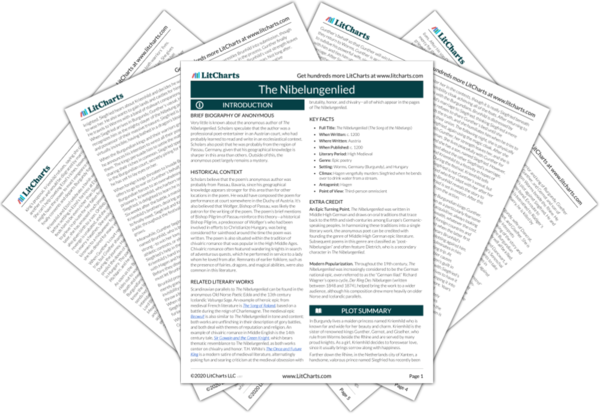Idealized and Deviant Womanhood
In The Nibelungenlied, a medieval German epic steeped in the history of the fifth and sixth centuries, female characters are relatively few, yet they are responsible for the driving events in the story. Kriemhild and Brunhild—a Burgundian princess and warrior-queen of Iceland, respectively—are the central women. However, the two are decidedly ambivalent women, in that both are highly desirable to men, yet each challenges expectations for proper feminine behavior in medieval Germany. At…
read analysis of Idealized and Deviant WomanhoodCivilization vs. Barbarism
The anonymous author of the heroic epic The Nibelungenlied is acutely aware of differences between native and foreigner, pagan and Christian, human and nonhuman (namely magical) creatures—distinctions reflective both of the story’s early medieval setting and the poet’s high medieval context, where such boundaries would have been ever-present sources of potential conflict. Using this tension throughout the story, the author establishes a world in which it is not only important that “barbaric” influences be tamed…
read analysis of Civilization vs. BarbarismHonor vs. Vengeance
In The Nibelungenlied, there is a tension between then-contemporary (high medieval) notions of honor and the survival of the older, tribal value of vengeance. Though the anonymous poet is not heavy-handed in championing honor, he ultimately deconstructs the older Germanic concept of vengeance, showing that it contains the seeds of its own undoing. In fact, the poem ends with such total destruction that it seems as if vengeance has won the day. However, the…
read analysis of Honor vs. Vengeance
Hospitality, Gifts, and Exchange
Hospitality and gift exchange are the major currency of the world of the story, written in the thirteenth century but featuring events that gesture back as far as the fifth century. Throughout The Nibelungenlied, characters repeatedly display their largesse by bestowing lavish gifts and extravagantly welcoming one another into their kingdoms. Yet they also frequently betray one another through treacherous, often deadly “repayments” and falsely hospitable gestures. While it would be anachronistic to say…
read analysis of Hospitality, Gifts, and ExchangeFate and Action
Throughout The Nibelungenlied, there is an apparent interplay between fate and action. Kriemhild and Hagen, arguably the most proactive and forceful characters in the story, never shrink from the path each has chosen. Yet The Nibelungenlied is permeated by a recurrent atmosphere of foreknowledge, supernatural influence, and inevitability. The poet does not seem concerned to parse this problem too finely; it was probably less of a contradiction in his mind than in the…
read analysis of Fate and Action






